What is the 3-2 zone defense in basketball
The 3-2 zone defense is a basketball defensive strategy that emphasizes the prevention of low post scoring opportunities while restricting dribble penetration with adequate on-ball defense and influencing poor shot selection, particularly near the perimeter areas of the court.
What is an example of the initial formation for the 3-2 zone defense
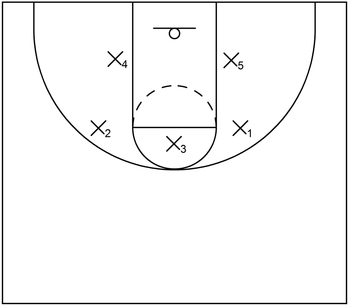
This is a typical example of the initial formation for the 3-2 zone defense. There are three defenders in the front of the zone and two defenders in the back of the zone.
X3 starts near the high post area while X1 and X2 start near the free throw line extended areas but inside of the three-point arc. Also, X4 and X5 start near the low post blocks.
What are the general responsibilities of the defenders within the 3-2 zone defense
The responsibilities of X3 are to cover the high post area and keep the ball out of the high post. The responsibilities of X1 and X2 are to cover the wing areas on the strong side or limit/prevent effective offensive action on the weak side.
The responsibilities of X4 and X5 are to guard the low post areas, protect the basket, or closeout to the corners.
What are advantages of 3-2 zone defense
One notable advantage of the 3-2 zone defense is that it could be effective against teams that prefer to score near the basket via one or more of their low post players, especially if those post players have above average low post skills.
Also, another strength of the 3-2 zone defense is that it could be useful against teams that do not have multiple three-point shooters, especially players that can shoot from the wings or corners.
Furthermore, teams that prefer to create scoring opportunities via dribble drive action could have problems against the 3-2 zone defense.
What is a disadvantage of 3-2 zone defense
One particular disadvantage of the 3-2 zone defense is that it essentially requires all five defenders to have a certain level of speed and quickness in order to execute proper defensive closeouts towards the perimeter areas of the court.
This, in turn, could prevent uncontested perimeter jump shots or undesirable dribble drive execution.
In other words, if the offensive team passes the ball around the perimeter, specifically near the wings or corners, then each of the zone defenders have to be fast enough to closeout and cover those same perimeter areas.
However, if a zone defender is not able to closeout to their respective perimeter area quickly enough or the zone defender executes a poor closeout, then that could lead to an open jump shot or dribble penetration towards the basket for the offensive team.
Affiliate Disclosure: I may earn a commission on qualifying purchases made through the links below.
What are examples of defensive rotations for the 3-2 zone defense
Example 1

This is a basic example of the 3-2 zone defense when the ball is at the top. X3 covers the high post near the top.
Also, for this case, 1 is not a long-distance shooter so X3 could apply only a moderate amount of defensive pressure. In other words, just enough to contest with a hand in the face if 1 were to take the long-distance shot.
X1 and X2 are near the free throw line extended areas inside of the arc ready to closeout if the ball get passed to the wings. X4 and X5 cover the low post areas for the time being.
Example 2

This is another example of the 3-2 zone defense when the ball is at the top and for this case, 1 can take deep perimeter jump shots.
Also, at the same time, 5 is near the low post block as opposed to being near the corner as with the previous diagram.
When that occurs, X3 could step out beyond the three-point arc at the top to apply a greater amount of defensive pressure than previously. In addition to that, X5 could cut into the lane to stay in front of 5.
This also prevents potential high low action between 1 and 5. In other words, if X5 was outside of the lane or behind 5, then 1 could possibly throw the ball over the top of X3 and then 5 could score near the basket; especially if X4 did not step into the lane to provide help defense.
Example 3

This is an example of the 3-2 zone defense when the ball is on the wing. X1 executes a closeout to prevent an open jump shot. X3 drops back to the high post elbow area to prevent middle dribble penetration.
X5 executes a full front on 5 to take away the post entry pass. X2 steps into the lane near the weak side mid-post area to take away a potential basket cut by 1. X4 steps into the lane to protect the basket.
Example 4
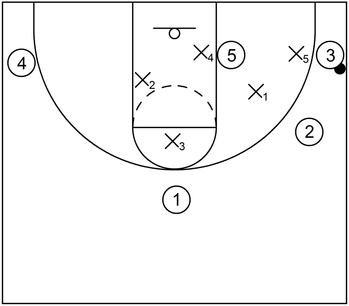
This is an example of the 3-2 zone defense when the ball is in the corner. X5 executes a closeout to prevent the uncontested three-point shot. X1 drops back to fill in the gap between 2 and 5.
This allows X1 to mitigate middle dribble penetration from the corner and prevent an easy post entry pass from the corner.
X4 slides over to guard 5 while X3 covers the high post area and X2 covers any weak side action. Also, it should be noted that X5 should not give up a baseline drive as that would cause complications for the zone.
Example 5
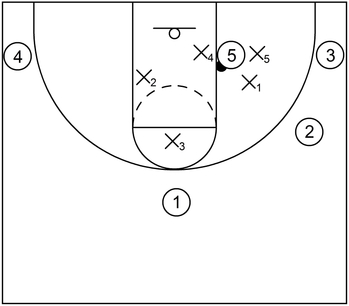
This is an example of the 3-2 zone defense when the ball gets into the low post. If that occurs, then X4 and X5 could double the post with high hands to prevent any opportunity to take a quality shot near the basket.
Additionally, X1 could attempt to steal the ball without fouling. Also, X3 continues to cover the high post area while X2 continues to watch for weak side offensive action.
Example 6
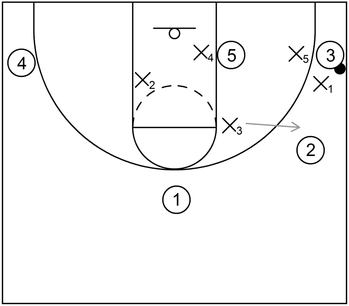
This is an example of the 3-2 zone defense that features a trap when the ball is in the corner. Essentially, X1 and X5 execute the corner trap with high hands and as that occurs, X3 has the option to intercept the ball (shown with the gray arrow) if 3 attempts to pass to 2.
However, it should also be noted that X3 should initially stay near the high post and then afterwards, anticipate when 2 might receive the pass from 3.
Basically, if X3 commits too early towards 2 before 3 executes the pass, then 3 could throw a skip pass to 1 instead.
If that were to happen, then X3 would probably not have enough time to recover to guard 1 at the top and that would effectively break down the zone defense.
Example 7
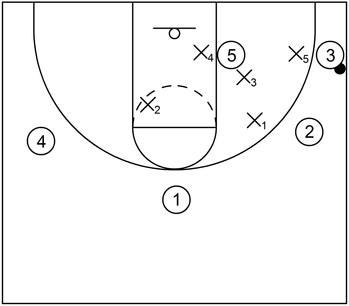
This is an example of the 3-2 sliding zone defense variation. For the 3-2 sliding zone defense, the middle defender could cover the high post area when the ball is at the top or on the wing or the low post area when the ball is in the corner.
This particular example is derived from Championship Gap Man-to-Man and Sliding Zone Defense by Jack Bennett.
For this diagram, the ball is in the corner and when that occurs, X3 fronts the low post player on the high side as opposed to covering the high post area in the standard 3-2 zone defense.
At the same time, X4 guards the low post player on the low side near the baseline. This, in essence, makes it very difficult to execute a post entry pass from the corner.
However, if the ball does happen to get into the low post area, that would create an automatic double team between X3 and X4.
Also, it should be noted that in the 3-2 sliding zone defense, even if 5 was not positioned near the strong side low post block, X3 would still drop down near the low post block while X4 stays in front of the basket.
This would effectively prevent an offensive player from simply cutting to the low post block to receive the ball from the corner.
In other words, in the 3-2 sliding zone defense, once the ball gets to the corner, the defensive objective is to keep the ball from getting into the low post, even if a offensive low post player is not currently positioned near the strong side low post block.
Example 8
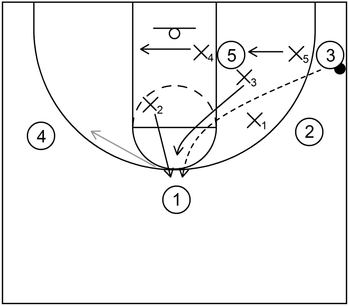
This is another example of the 3-2 sliding zone defense. This time, 1 at the top receives a skip pass from 3 in the corner. When that occurs, X3 will probably not have enough time to recover and guard 1 at the top.
So, to alleviate this problem, X2 steps up to temporarily guard 1. At the same time, X3 sprints back to the top and then X2 bumps (or slides over) to the correct spot near the free throw line extended area, shown with the gray arrow.
Additionally, X4 and X5 slide back to the correct defensive positions as well because the ball is at the top.
Example 9
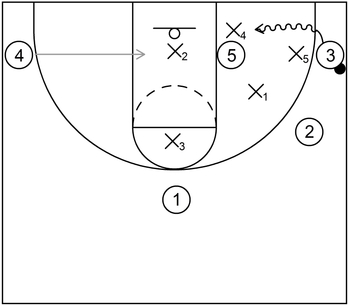
This is an example of the 3-2 zone defense when the offensive player in the corner is able to dribble towards the baseline. When that occurs, X4 steps out of the lane to fill the baseline area below the low post block.
This basically stops further dribble penetration. Also, X2 would have to sink down to protect the basket.
Unfortunately, this situation is not ideal at all for the defensive team because X2 most likely would be mismatched against the offensive team’s post player.
For this case, that would be 5 and if that offensive post player has above average low post skills, then that is most certainly a scoring opportunity for the offensive team.
Furthermore, 4 could cut to the basket as the dribble penetration from 3 occurs, represented by the gray arrow.
Afterwards, 5 or 4 could have scoring opportunities if 3 were to pass the ball to either of them because X2 can’t efficiently guard both of them. This is why it is important not to give up baseline drives whenever it is possible.